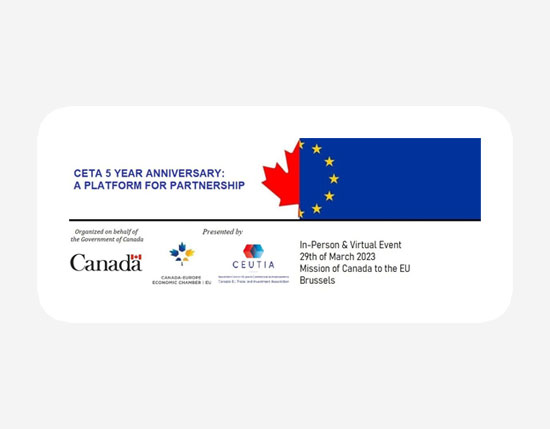Newsletter – March 2023
Newsletter from Brussels - Capital of the European Union - March 2023
NEWS

29th of March 2023, Mission of Canada to the EU, Brussels
CETA 5 Year Anniversary:
A Platform for Partnership

Description
The European Union (EU) is one of the largest economies in the world and Canada’s second-largest trading partner. The Canada-European Union Comprehensive Economic and Trade Agreement (CETA) presents Canadian businesses with preferential access to and excellent opportunities for growth in the EU. September 21, 2022 marks the fifth anniversary of CETA’s provisional application. The Agreement will come into full effect when all EU Member States have completed the ratification process. Until then provisional application of CETA will continue and remain accessible to Canadian and EU business alike.
CETA explained
The Canada-European Union Comprehensive Economic and Trade Agreement (CETA) is a bilateral agreement between Canada and the EU. The agreement covers virtually all sectors and aspects of Canada-EU trade in order to eliminate or reduce barriers.
Why CETA matters
CETA represents the best in international trade agreements. CETA sets new standards for trade in goods and services, non-tariff barriers, investment, government procurement, and other areas like labour and the environment.
The EU is one of the largest economies in the world and Canada’s second-largest trading partner after the United States. It is also the world’s second-largest importing market for goods. The EU’s annual imports alone are worth more than Canada’s GDP. By opening new markets in the EU to Canadian exporters, CETA gives us a competitive advantage in the global market, which benefits all Canadians.
CETA is helping to create jobs, strengthen economic relations and boost Canada’s trade with the world’s second-largest market.
What CETA covers
CETA covers virtually all sectors and aspects of Canada-EU trade in order to eliminate or reduce barriers:
- Trade in goods: CETA eliminates tariffs and reduces barriers for virtually all sectors and aspects of Canada-EU trade. Prior to this agreement, only 25% of EU tariff lines on Canadian goods were duty-free. With CETA, 98% of EU tariff lines are now duty-free for Canadian goods.
- Rules of origin: Canadian exporters have clear and favourable rules that consider Canada’s supply chains to determine which products are considered originating and therefore eligible for preferential tariff treatment.
- Customs and trade facilitation: Canada and the EU are working to keep customs procedures simple, effective, clear and predictable. This reduces processing times at the border and makes it easier to move goods between countries.
- Regulatory cooperation and conformity assessment: CETA helps avoid unnecessary or discriminatory regulatory requirements. Canadian and EU regulators are collaborating to create regulatory measures that make it easier for Canadians to do business in the EU.
- Government procurement: Canadian companies can bid on opportunities at all levels of government in the EU, opening potential business estimated at $3.3 trillion annually.
- Trade in services and labour mobility: CETA provides Canadian service providers with more business opportunities in the EU and makes it easier for certain skilled professionals to work temporarily in the EU.
- Investment: Investment provisions in CETA are designed to give investors greater certainty, stability and protection for their investments and to provide access to an independent dispute resolution mechanism.
- Sustainable development, labour and the environment: CETA includes clear commitments to uphold Canada’s high standards and not to undermine them for commercial gain. Clear language confirms the right to regulate for all levels of government.
What it means for Canadian businesses
Here’s how CETA helps businesses across Canada:
- Competitiveness: Gives Canadian businesses preferential access to one of the largest economies in the world.
- Access to new clients: Allows Canadian businesses to supply goods and services to all levels of EU governments, including governments of EU member states. It also offers new opportunities with regional and local governments.
- Market transparency and stability: Sets requirements for product standards, investment, professional certification and other areas of activity. It also includes labour rights and environmental protection.
- Reduced barriers to trade: Makes it easier to move goods across borders and for business people to get to the right place at the right time to pursue opportunities.
TRADE

Commerce Trends 2023
Shopify has released their 2023 Commerce Trends Report. The report provides an overview of the current state of e-commerce and highlights emerging e-commerce trends, including information on new technologies and business models that are shaping the industry, such as social commerce, mobile commerce, and subscription-based models.

The only constant in commerce is change. And the only way forward is to adapt. In the past year, we’ve seen millions of businesses display resilience in the face of the unexpected, contributing to over $27 trillion USD1 of retail sales worldwide. But 64% of global businesses are still recovering from the negative impact of the pandemic.
Economic obstacles from the pandemic were compounded further in 2022, when the Russia-Ukraine war led to sanctions that delayed or halted trade altogether. The fiscal instability is driving the highest inflation in 40 years.
Online shopping jumped 77% year over year just months into the pandemic, accelerating the innovation and adoption of digital commerce by half a decade. Shopping, working, and socializing online became commonplace. But after years of lockdowns and restrictions, people now crave meaningful connection across all facets of life—including commerce. Physical spaces make those points of connection between merchants and customers possible, including online and offline commerce.
As brands grapple with the challenges in 2023, they’ll need to respond by adding flexibility to their products, plans, and policies. With an economic recession on the horizon, being agile has never been more important. This report outlines the global trends equipping brands to confront the unexpected.
- Embrace flexible commerce: If the past few years in online commerce have taught us anything, it’s that merchants need to be able to quickly respond to change in order to thrive. This need for adaptability is encapsulated by the idea of Flexible Commerce, which argues that merchants need tools that can be tailored to their brand, customer base, and operational needs at a pace measured in weeks rather than months.
- Focus on sustainability with “recommerce”: in 2023 we’ll see the continued expansion of the “recommerce” trend—the selling of previously owned goods. Recommerce showcases the continued—and growing—importance of sustainability in the ecommerce space, which in turn encourages brands to engage with more environmentally sound practices. Recommerce also offers a more cost-effective solution to consumers than buying brand-new products, Abbott points out. Given the challenging economic climate, this is going to be more important than ever.
- Differentiate your in-store experience: As lockdown restrictions eased after the height of the COVID-19 pandemic, consumers started to return to physical stores. Consumers continue to want experience-led brick and mortar stores, highlighting the importance of creating purposeful spaces that elevate the brand and—ultimately—create great buying experiences.
- Invest in customer loyalty: Paid acquisition costs skyrocketed in 2022. This, combined with less ability to track paid advertising’s impact on sales in a now cookie-less, privacy-centric world, means that customer retention is now more important than ever
- Maximize customer lifetime value: Merchants need to figure out how they can help their customers succeed, and if they do so in a way that makes the brand uniquely different from others—beyond rolling out a loyalty program or turning on subscriptions.
- Own your brand identity: The looming global recession will have a strong impact on commerce trends in 2023, which also means that ecommerce businesses will face challenges with reduced consumer spending. Customers simply won’t have as much money to spend on products as in previous years.
- Automate and outsource to reduce costs: financial challenges mean ecommerce companies should specifically have two things in mind when it comes to optimizing profit: automation and outsourcing.
- Put more emphasis on social commerce: As search engine results pages become increasingly dominated by sponsored placements, customers are starting their purchasing journeys in other places—such as social media. In fact, a recent Statista survey showed that over 60 percent of shoppers between 18 and 34 made a purchase as a result of branded social posts. User-generated content helps reinforce the merchant-customer relationship. As an added bonus, UGC also doubles up as free, authentic marketing content for the business.
- Bring products to life through augmented reality: Augmented reality (AR) will be an increasingly leveraged technology in commerce in 2023. We’re now on the cusp of a new era of digital connection, and AR—as a way to personalize products and enhance the shopping experience—is becoming a viable option as more consumers around the world adopt the technology.
Stores can showcase 360-degree views of products on the product pages for one level of personalization.
EVENTS

UPCOMING EVENTS
29-03-2023 – Canada-Europe Economic Chamber – EU
CETA 5 Year Anniversary: A Platform for Partnership
Mission of Canada to the EU, Brussels
12-05-2023 – Canada-Europe Economic Chamber – EU
Germany-Canada:
A Reliable Relationship in a New Industrial Revolution
Embassy of Canada to Germany, Berlin
18-10-2023 – Canada-Europe Economic Chamber – EU
EU-Canada Business Summit 2023
Cercle Royal Gaulois, Brussels

Montreal • Brussels • Ottawa • Paris •T
Madrid • Winnipeg • Rome • Quebec • Oslo • Edmonton • Vienna • Victoria • Dublin • Regina • Lisbon • Halifax
Athens • St-John’s • Copenhagen • Moncton • Bratislava • Saskatoon • Budapest • Windsor • Warsaw • Charlottetown
Bucharest • Sherbrooke • Luxembourg • Yellowknife • Helsinki • Whitehorse • Geneva • Kitchener • Prague • Gatineau
Sofia • Red Deer • Zagreb • Fredericton • Talinn • Sudbury • Nicosia • Kingston • Ljubjana • Lethbridge • Valletta
Thunder Bay • Vilnius • Cornwall • Riga • Trois-Rivières • Zurich • Kelowna • Stockholm • Saguenay • Reykavik